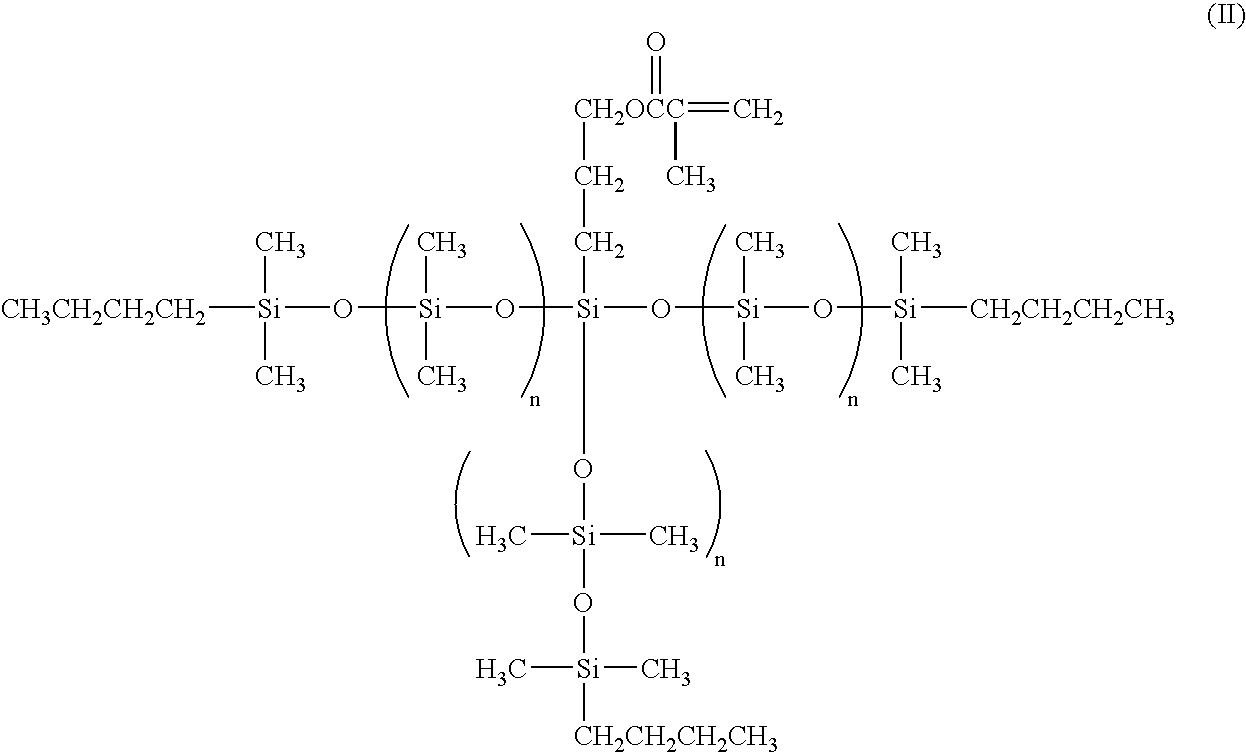Low molecular weight siloxanes with one functional group
a technology of functional groups and low molecular weight, applied in the field of low molecular weight siloxanes with one functional group, can solve the problems of reducing mechanical properties, separating molecules, cloudy, etc., and achieving the effect of reducing the number of functional groups
- Summary
- Abstract
- Description
- Claims
- Application Information
AI Technical Summary
Problems solved by technology
Method used
Image
Examples
example 1a
Synthesis of Bis[(n-butyldimethylsiloxy)polydimethylsiloxy](methacryloxypropyl)methylsilane
[0028]
[0029]A 3 L 4 neck flask equipped with an overhead stirrer, pot thermometer, reflux condenser, water bath and addition funnel was blanketed with nitrogen and charged with 292.8 g (1.316 moles) of hexamethylcyclotrisiloxane and 374.5 g of hexane. A half molar equivalent addition of n-butyllithium (460 ml of 1.64M hexane solution) was made rapidly through the addition funnel. An exotherm was observed (18.7° to 37.5° C.). Thereafter, cooling was used to maintain the temperature below 40° C. The mixture was stirred for one hour and then 107.3 g (1.468 moles) of dimethylformamide (DMF) were added at once. A slight exotherm was observed, pot temperature rose from 24.0° to 29.5° C., and the mixture was stirred for four hours. The coupling reaction was accomplished by adding 0.040 g of p-methoxyphenol (MEHQ), followed by the addition of 88.5 g of methacryloxypropylmethyldichlorosilane over fifte...
example 1b
Synthesis of Bis[(n-butyldimethylsiloxyolydimethlsiloxy](methacryloxypropyl)methylsilane
[0030]This Example is a variation on Example 1A. A 3 L 4 neck flask equipped with an overhead stirrer, pot thermometer, reflux condenser, water bath and addition funnel was blanketed with nitrogen and charged with 172.8 g (0.776 moles) of hexamethylcyclotrisiloxane and 401.4 g of hexane. A molar equivalent addition of n-butyllithium (475 ml of 1.64M hexane solution) was made rapidly through the addition funnel. An exotherm was observed (16.0° to 28.0° C.). Thereafter, cooling was used to maintain temperature below 40° C. The mixture was stirred for one hour and then 113.8 g (1.5568 moles) of dimethylformamide (DMF) were added at once. A slight exotherm was observed, pot temperature rose from 19° to 26° C., and the mixture was stirred for four hours. The coupling reaction was accomplished by adding 0.030 g of p-methoxyphenol (MEHQ), followed by the addition of 93.4 g of methacryloxypropylmethyldic...
example 2
Synthesis of Tris[(n-butyldimethylsiloxy)polydimethylsiloxy]methacryloxypropylsilane
[0031]
[0032]A 3 L 4 neck flask equipped with an overhead stirrer, pot thermometer, reflux condenser and addition funnel was blanketed with nitrogen and charged with 175.2 g (0.787 moles) of hexamethylcyclotrisiloxane and 394.4 g of hexane. A molar equivalent addition of n-butyllithium (490 ml of 1.64M hexane solution) was made rapidly through the addition funnel. An exotherm was observed (18.2° to 33.5° C.). Thereafter, cooling was used to maintain the temperature below 40° C. The mixture was stirred for one hour, and then 114.4 g (1.565 moles) of dimethylformamide (DMF) were added at once. A slight exotherm was observed, pot temperature rose from 24.6° to 30.2° C., and the mixture was stirred for four hours. The coupling reaction was accomplished by adding 0.03 g of p-methoxyphenol (MEHQ), followed by the addition of 64.0 g of methacryloxypropyltrichlorosilane over fifteen minutes. Pot temperature r...
PUM
| Property | Measurement | Unit |
|---|---|---|
| molecular weight | aaaaa | aaaaa |
| molecular weight | aaaaa | aaaaa |
| molecular weight | aaaaa | aaaaa |
Abstract
Description
Claims
Application Information
 Login to View More
Login to View More - R&D
- Intellectual Property
- Life Sciences
- Materials
- Tech Scout
- Unparalleled Data Quality
- Higher Quality Content
- 60% Fewer Hallucinations
Browse by: Latest US Patents, China's latest patents, Technical Efficacy Thesaurus, Application Domain, Technology Topic, Popular Technical Reports.
© 2025 PatSnap. All rights reserved.Legal|Privacy policy|Modern Slavery Act Transparency Statement|Sitemap|About US| Contact US: help@patsnap.com



